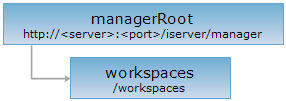<managerRoot_uri>/workspaces[.<format>]
The workspaces resource lists all current workspaces. You can quickly publish a workspace as GIS services through the POST requests. Currently, only UGC workspace is supported to be published. For related samples, please refer to Quickly Publishing GIS Services (Through REST API). To delete a service instance corresponding to one specific workspace, use PUT operation.
Supported Methods:
Supported output formats: RJSON, JSON, HTML, XML.

Execute HTTP request on the following URI, here we take rjosn as the output format as an example. Where, supermapiserver is the server name.
http://localhost:8090/iserver/manager/workspaces.rjson
Gets all current workspaces.
After executing a GET request on the resource, the response entity is a list of workspaces, and the response fields of single workspace are as follows:
| Field | Type | Description |
| address | String | Workspace file path. |
| enabled | boolean | Marks whether the service is available. |
| message | String | If enabled is false, ie., the service is unavailable, message will show the reason. |
| name | String | Workspace name, such as: China400.smwu. |
| serviceName | String | Service name, such as: map-china400/rest. |
| serviceType | String | Service type, which can be Map, Data, 3D, TransportationAnalyst, SpatialAnalyst and TrafficTransferAnalyst, etc. |
By executing a GET request on workspaces resource with URI: http://localhost:8090/iserver/manager/workspaces.rjson, the returned response result in rjosn format is as follows:
Quickly publishes the workspace as GIS services.
The following parameters are needed in the request body
| Name | Type | Description |
| workspaceConnectionInfo | String | [Required] Such as, for a database workspace, use the following connection: |
| servicesTypes | [Required] Service types to be published. While publishing multiple services, use "," to separate each type. |
|
| isDataEditable | boolean | Required if servicesTypes is RESTDATA, WFS100, WCS111 or WCS112, which indicates whether the data of the service is editable. False denotes "Uneditable". |
| datasourceInfos | FilteredDatasourceInfo | [Optional. Only used when publishing data services.] Used to filter the datasets to be published when publishing data services. |
| transferLineSetting | Bus line environment settings for publishing traffic transfer services. | |
| transferNetName | String | Traffic network name for publishing traffic transfer services. |
| transferRelationSetting | Bus stop and line relationship settings for publishing traffic transfer services. | |
| transferStopSetting | Bus stop environment settings for publishing traffic transfer services. | |
| unit | Unit of the stop caputuring tolorance, tolerance for merging stops with the same name, and walking tolerance for transferring. Default value is meter. | |
| walkingTolerance | double | Walking tolerance for transferring used when publishing traffic transfer services. Defaults to 1000. |
| mergeTolerance | double | Tolerance for merging stops with the same name used when publishing traffic transfer services. |
| snapTolerance | double | Stop caputuring tolorance for publishing traffic transfer services. |
| transportationAnalystSetting | TransportationAnalystSetting | Provider Environment setting class for publishing transportation analysis service. |
| facilityAnalyst3DSetting | UGCNetworkAnalyst3DSetting | Provider Environment setting class for publishing 3D facility network analysis service. |
|
addressMatchProviderSetting |
UGCAddressMatchProviderSetting | Provider Environment setting class for publishing address matching service. |
The response result is the array composed by the published GIS services. Each info includes:
| Field | Type | Description |
| serviceAddress | String | The published available service address. |
| serviceType | Service type. |
Perform a POST request on the workspaces resource with URI: http://localhost:8090/iserver/manager/workspaces.rjson to quickly publish the workspace World.sxwu as RESTMAP srevice:
{
"servicesTypes": ["RESTMAP", "RESTDATA", "WMS111"],
"workspaceConnectionInfo": "../samples/data/World/World.sxwu"
}
the returned created service would be as follows:
[{
"serviceAddress": "http://localhost:8090/iserver/services/map-world2/rest",
"serviceType": "RESTMAP"
},
{
"serviceAddress": "http://localhost:8090/iserver/services/data-world2/rest",
"serviceType": "RESTDATA"
},
{
"serviceAddress": "http://localhost:8090/iserver/services/map-world2/wms111",
"serviceType": "WMS111"
}]
This example we'll filter the datasets to be published to publish a data service by performing a POST request on workspaces resource with URI: http://localhost:8090/iserver/manager/workspaces.rjson, and the request body is as follows:
{
"workspaceConnectionInfo": "F:/4.datastore/Data/data/DynamicData/DynamicData.smwu",
"servicesTypes": [
"RESTDATA"
],
"datasourceInfos": [
{
"connInfo": {
"alias": "DynamicData",
"server": "F:/4.datastore/Data/data/DynamicData/DynamicData.udb",
"engineType": "UDB"
},
"includedDatasetNames": [
"Point"
]
}
]
}
the returned created service is as follows:
{
"serviceAddress": "http://localhost:8090/iserver/services/data-DynamicData5/rest",
"serviceType": "RESTDATA"
}
Simulates DELETE to delete the service instance corresponding to the specified workspace.
Needed parameters in the request body:
| Name | Type | Description |
| workspaceConnectionInfo | String | [Required] Workspace file path or database connection info. Such as, for a database workspace, use the following connection: |
The returned resource representation structure of the response entity is as follows:
| Field | Type | Description |
| succeed | boolean | Whether the workspace has been deleted successfully. |
Perform a PUT request on workspaces resource with URI: http://localhost:8090/iserver/manager/workspaces.rjson to delete the workspace China400.smwu and the following request body:
{
"workspaceConnectionInfo":"../../samples/data/China400/China400.smwu"
}
the returned response result in rjson format is as follows:
{"succeed": true}
Returns the same HTTP response header as the GET request, but no response entity, which can be used to retrieve the meta data contained in response message header without having to transmit the entire response content. Meta data information includes media type, character coding, compression coding, entity content length, etc.
HEAD request is used to determine whether the workspaces resource exists, or if the user has the authority to access it. By executing an HEAD request with a .<format> URI, you can quickly determine whether the workspaces resource supports the <format> representation.